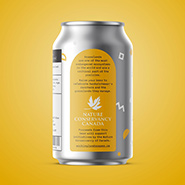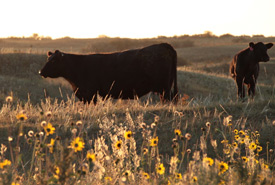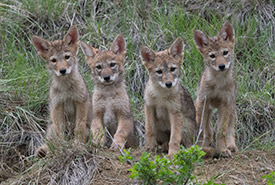Cheers to colla’beer’ation for conservation

Nokomis Craft Ales special edition (Photo by Jeff Allport)
The Nature Conservancy of Canada (NCC) recently announced a colla”beer”ation with Nokomis Craft Ales, a brewery located in the rural community of Nokomis, Saskatchewan, who are pouring out $0.50 per can to support NCC initiatives. As indicated on the can, “Grasslands are one of the most endangered ecosystems in the world and are a critical part of the prairies. Raise your beer to celebrate Saskatchewan’s ranchers and the grasslands they manage.”
Close to Nokomis Craft Ales lies a unique and thriving landscape known as the Wreford Nokomis Pasture. This pasture is home to a dedicated group of individuals who work tirelessly to preserve and manage its native grasslands while providing a sustainable grazing environment for their cattle. Among them is Don Gingrich, a passionate rancher who serves as a member of the Wreford Nokomis Pasture Board of Directors. We recently sat down with Don to ask him a few questions.
Why have you chosen agriculture as a career?
Agriculture runs in my blood. Growing up on a farm, I developed a natural affinity for the rural lifestyle and working with animals. Seeing the growth and development of animals and witnessing the beauty of nature in the pasture brings me immense joy. While farming has its challenges, the rewarding aspects make it all worthwhile. A lot of people can hardly wait for the weekend so they can go golfing or camping or anything that gets them away to spend time among trees and grass. I have that everyday I leave the house! I feel privileged to have made agriculture my career.
What are some fun stories about your cattle?
In our herd, the average cow is productive for eight to 10 years. However, we’ve had a few exceptional producers over the years. One that comes to mind was in the herd for 17 years and in that time raised 18 calves. Considering the first calf is born to the cow at two years of age this was quite a feat. Twins help fill in the extras. When it comes to memorable cows, the difficult ones usually stand out. One example is the cow who calved at 2 a.m. in a -20 C blizzard. There was no way she was going to let me get a hold of her calf to take him into the warm barn. I finally had to get the tractor with the front-end loader to use as a shield to get the calf, and then to add insult to injury she ran off to hide. I guess the barn wasn’t her happy place! Each cow has its unique personality, and their antics make ranching both interesting and occasionally hilarious.
What is your role with the Wreford Nokomis Pasture?
As far as becoming a part of the board of directors, when the Ministry of Agriculture announced the transition of the pastures to private operation, I realized that if we didn’t step up and make this work for all the interested members, there was a high probability the land would be sold. I felt that because the pasture bordered my farm, it was in my best interests to do what I could to help it succeed. I am one of six Board of Directors of the Wreford Nokomis Pasture. As the secretary/treasurer, I play an important role in the financial management of the pasture. I also serve as one of the primary contacts for anyone having pasture related business and relay these conversations to the other Board members.
How many members belong to the Wreford Nokomis Pasture?
The pasture has 21 members who deliver around 1,800 head of predominately cow/calf pairs. These cattle are rotationally grazed through the fields in the Wreford Nokomis Pasture and additional areas leased from the Canadian Wildlife Service, an area adjacent to the pasture.
What are some of the challenges you face?
Every year presents its own set of challenges. Weather fluctuations, such as excessive wetness or dryness, extreme temperatures and infrastructure malfunctions, are common obstacles. However, as a pasture model, we benefit from the combined expertise of our patron group. Many members are willing to lend a hand, and working together to find solutions makes the job engaging and fulfilling.
What would the landscape look like without cattle grazing?

Cattle on prairie grasslands (Photo by Tamara Carter)
The native grasslands in the pasture have evolved to thrive with cattle grazing. If cattle were absent, several consequences would arise. Previous year's growth would accumulate, eventually suffocating new plant growth and leading to the potential for prairie fires. Additionally, the absence of grazing would disrupt the habitat of various species that rely on the grasslands. Some species need shorter grass to survive, while others need longer grass. It’s also interesting how many migratory birds return to the same area they hatched in or had a successful nesting experience. I’ve seen evidence of this happening around my own yard over the years and it’s heartwarming to see the birds come back.
What would you say in response to some recent media messages around cattle production?
Cattle receive a large amount of bad press regarding the contributions they make toward climate change. However, when cattle graze the grass, the normal response of the plant is to replace the leaves of the plant they ate with new growth. With proper management this cycle continues indefinitely. To grow plants requires CO2, so cattle are capturing carbon every day, and as a bonus they provide a high-quality protein source to feed the world. Grasslands also capture and store billions of tonnes of carbon. Maintaining a healthy balance between cattle grazing and habitat preservation is crucial for the survival and sustainability of both.
What are some of the investments needed to keep grazing happening on native prairie?
In our pasture, we are currently focusing on water infrastructure, specifically water pipeline expansion and strategically placed troughs. High salinity levels in the soil make many surface water sources unfit for cattle consumption. By improving the water system, we can distribute the cattle more evenly across the fields, use previously ignored grazing areas, and minimize damage to riparian zones. Collaborations with organizations like NCC and the Weston Family Prairie Grassland Initiative help us implement these vital investments.
What are your favourite animals to spot in the pasture?

Coyote pups (Photo by Jason Bantle)
I would describe myself as an animal person, so I enjoy seeing any of the animals that call the pasture home. I’m always on the look out for the spring babies whether it’s fawns, coyotes, fox pups or young Canada geese. One year there were three young badgers outside the opening of their den, I slowly drove up to them in the truck until I was only a couple of metres from them, thinking they would hide down their hole. Instead, they ran right up to the truck growling and snarling to chase me off. I’m glad they couldn’t jump through my window. Another unusual bird we don’t usually see in this area is the turkey vulture. A pair has nested in some old buildings on the pasture for several years now. Because of the increased requirements for various maintenance jobs in the pasture, I’ve spent a lot more time off the road and back in areas of the pasture that are several miles from any human activity. There are areas where it’s tough to see any of the landmarks that I would use to find my bearings. It’s in these areas that the wildlife population is noticeably larger than in the farmed areas. It indicates to me that cows and wildlife can cohabitate very well together.
What is your favourite flower found in the pasture?
My favourite flower would be the crocus; it’s the first sign of the end of winter. There is also an area of the pasture that, when under the right moisture conditions, you can spot many vibrant prairie lilies.
What was it like growing up on a farm next to a pasture?
Growing up on a farm and beside the pasture, I cherish the memories of trail drives with cattle, summer swims in the nearby lake, winter skates on the ice and the freedom of farm life. It is this deep-rooted connection to the land and the joy it brings that fuels my dedication to agriculture. And my favourite meal — a hearty roast beef dinner — serves as a reminder of the abundance and quality of the food we help produce. As I work hand in hand with fellow ranchers and the community, I hope to inspire future generations to appreciate and understand the profound connection between agriculture, wildlife and the land we call home.
To help inspire future generations you participated in the Adopt a Rancher program. What is the program?
The Adopt a Rancher program, indirectly linked to me, is offered through the high school system in Regina. It aims to bridge the gap between urban students and the farming community. By partnering with organizations like NCC, we assist in providing pasture assessments, grazing plans and education on native grass species to students. It's vital for the younger generation to understand the origins of their food and support the agriculture industry.
The Wreford Nokomis Pasture stands as a testament to the dedication and passion of the ranchers who have come together to protect the native grasslands and create a sustainable grazing environment. Through their collective efforts and collaboration with organizations like NCC, they have been able to overcome challenges and ensure the long-term viability of the pasture. Their commitment to responsible land management and the coexistence of wildlife and cattle exemplifies the harmony that can be achieved in the agricultural industry.
It's encouraging to see the growing interest in conservation agreements and land stewardship programs that support landowners in protecting grasslands. These initiatives ensure the long-term conservation of these valuable habitats while enabling ranchers to continue their livelihoods in harmony with nature. For more information, visit worklinglandscapes.ca.



